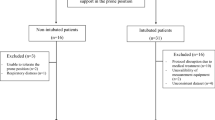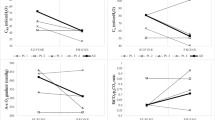Abstract
Prone positioning with continuous positive airway pressure (CPAP) is widely used for respiratory support in awake patients with COVID-19-associated acute respiratory failure. We aimed to assess the respiratory mechanics and distribution of ventilation in COVID-19-associated ARDS treated by CPAP in awake prone position. We studied 16 awake COVID-19 patients with moderate-to-severe ARDS. The study protocol consisted of a randomized sequence of supine and prone position with imposed positive end-expiratory pressure (PEEP) of 5 and 10 cmH2O delivered by helmet CPAP. Respiratory mechanics and distribution of ventilation were assessed through esophageal pressure (PES) and electrical impedance tomography (EIT). At the end of each 20-min phase, arterial blood gas analysis was performed, and PES swing and EIT tracings were recorded for the calculation of the respiratory mechanics and regional ventilation. The patient’s position had no significant effects on respiratory mechanics. EIT analysis did not detect differences among global indices of ventilation. A significant proportion of pixels in the sternal region of interest showed an increase in compliance from the supine to prone position and PaO2/FIO2 increased accordingly. The best improvement of both PaO2/FIO2 and sternal compliance was obtained in the prone position with PEEP 10 cmH2O. In the studied subjects, prone positioning during CPAP treatment raised oxygenation without improvement of “protective” ventilation or global ventilatory inhomogeneity indices. Prone positioning with higher PEEP significantly increased the compliance of sternal regions.



Similar content being viewed by others
Availability of data and material
The datasets used and/or analyzed during the current study are available from the corresponding author upon reasonable request.
References
Bellani G, Grasselli G, Cecconi M, Antolini L, Borelli M, de Giacomi F et al (2021) Noninvasive ventilatory support of patients with COVID-19 outside the intensive care units (WARd-COVID). Ann Am Thorac Soc 18:1020–1026
Guérin C, Reignier J, Richard J-C, Beuret P, Gacouin A, Boulain T et al (2013) Prone positioning in severe acute respiratory distress syndrome. N Engl J Med 368:2159–2168
Mathews KS, Soh H, Shaefi S, Wang W, Bose S, Coca S et al (2021) Prone positioning and survival in mechanically ventilated patients with coronavirus disease 2019-related respiratory failure. Crit Care Med 49:1026–1037
Langer T, Brioni M, Guzzardella A, Carlesso E, Cabrini L, Castelli G et al (2021) Prone position in intubated, mechanically ventilated patients with COVID-19: a multi-centric study of more than 1000 patients. Crit Care 25:128
Fossali T, Pavlovsky B, Ottolina D, Colombo R, Basile MC, Castelli A et al (2022) Effects of prone position on lung recruitment and ventilation-perfusion matching in patients with COVID-19 acute respiratory distress syndrome: a combined CT scan/electrical impedance tomography study. Crit Care Med. https://doi.org/10.1097/CCM.0000000000005450
Scaravilli V, Grasselli G, Castagna L, Zanella A, Isgrò S, Lucchini A et al (2015) Prone positioning improves oxygenation in spontaneously breathing nonintubated patients with hypoxemic acute respiratory failure: a retrospective study. J Crit Care 30:1390–1394
Longhini F, Bruni A, Garofalo E, Navalesi P, Grasselli G, Cosentini R et al (2020) Helmet continuous positive airway pressure and prone positioning: a proposal for an early management of COVID-19 patients. Pulmonology 26:186–191
Coppo A, Bellani G, Winterton D, di Pierro M, Soria A, Faverio P et al (2020) Feasibility and physiological effects of prone positioning in non-intubated patients with acute respiratory failure due to COVID-19 (PRON-COVID): a prospective cohort study. Lancet Respir Med 8:765–774
Jouffroy R, Darmon M, Isnard F, Geri G, Beurton A, Fartoukh M et al (2021) Impact of prone position in non-intubated spontaneously breathing patients admitted to the ICU for severe acute respiratory failure due to COVID-19. J Crit Care 64:199–204
Kaur R, Vines DL, Mirza S, Elshafei A, Jackson JA, Harnois LJ et al (2021) Early versus late awake prone positioning in non-intubated patients with COVID-19. Crit Care 25:340
Ehrmann S, Li J, Ibarra-Estrada M, Perez Y, Pavlov I, McNicholas B et al (2021) Awake prone positioning for COVID-19 acute hypoxaemic respiratory failure: a randomised, controlled, multinational, open-label meta-trial. Lancet Respir Med 9:1387–1395
Li J, Luo J, Pavlov I, Perez Y, Tan W, Roca O et al (2022) Awake prone positioning for non-intubated patients with COVID-19-related acute hypoxaemic respiratory failure: a systematic review and meta-analysis. Lancet Respir Med 10:573–583
Fralick M, Colacci M, Munshi L, Venus K, Fidler L, Hussein H et al (2022) Prone positioning of patients with moderate hypoxaemia due to COVID-19: multicentre pragmatic randomised trial (COVID-PRONE). BMJ 376:e068585
Stilma W, Åkerman E, Artigas A, Bentley A, Bos LD, Bosman TJC et al (2021) Awake proning as an adjunctive therapy for refractory hypoxemia in non-intubated patients with COVID-19 acute respiratory failure: guidance from an International Group of Healthcare Workers. Am J Trop Med Hyg 104:1676–1686
Rauseo M, Mirabella L, Laforgia D, Lamanna A, Vetuschi P, Soriano E et al (2021) A pilot study on electrical impedance tomography during CPAP trial in patients with severe acute respiratory syndrome coronavirus 2 pneumonia: the bright side of non-invasive ventilation. Front Physiol 12:728243
Brunin Y, Despres C, Pili-Floury S, Besch G (2021) Lung recruiting effect of prone positioning in spontaneously breathing patients with COVID-19 assessed by electrical impedance tomography. Am J Respir Crit Care Med 204:476–477
ARDS Definition Task Force, Ranieri VM, Rubenfeld GD, Thompson BT, Ferguson ND, Caldwell E et al (2012) Acute respiratory distress syndrome: the Berlin Definition. JAMA 307:2526–2533
Coppadoro A, Zago E, Pavan F, Foti G, Bellani G (2021) The use of head helmets to deliver noninvasive ventilatory support: a comprehensive review of technical aspects and clinical findings. Crit Care 25:327
Mauri T, Alban L, Turrini C, Cambiaghi B, Carlesso E, Taccone P et al (2017) Optimum support by high-flow nasal cannula in acute hypoxemic respiratory failure: effects of increasing flow rates. Intensive Care Med 43:1453–1463
Mauri T, Spinelli E, Pavlovsky B, Grieco DL, Ottaviani I, Basile MC et al (2021) Respiratory drive in patients with sepsis and septic shock: modulation by high-flow nasal cannula. Anesthesiology 135:1066–1075
Chiumello D, Chiodaroli E, Coppola S, Cappio Borlino S, Granata C, Pitimada M et al (2021) Awake prone position reduces work of breathing in patients with COVID-19 ARDS supported by CPAP. Ann Intensive Care 11:179
Costa EL, Borges JB, Melo A, Suarez-Sipmann F, Toufen C, Bohm SH et al (2009) Bedside estimation of recruitable alveolar collapse and hyperdistension by electrical impedance tomography. Intensive Care Med 35:1132–1137
Menga LS, Delle Cese L, Rosà T, Cesarano M, Scarascia R, Michi T et al (2023) Respective effects of helmet pressure support, continuous positive airway pressure, and nasal high-flow in hypoxemic respiratory failure: a randomized crossover clinical trial. Am J Respir Crit Care Med 207(10):1310–1323. https://doi.org/10.1164/rccm.202204-0629OC
Coppola S, Chiumello D, Busana M, Giola E, Palermo P, Pozzi T, Steinberg I, Roli S et al (2021) Role of total lung stress on the progression of early COVID-19 pneumonia. Intensive Care Med 47(10):1130–1139. https://doi.org/10.1007/s00134-021-06519-7. (Epub 2021 Sep 16)
Zang X, Wang Q, Zhou H, Liu S, Xue X, COVID-19 Early Prone Position Study Group (2020) Efficacy of early prone position for COVID-19 patients with severe hypoxia: a single-center prospective cohort study. Intensive Care Med 46:1927–1929
Pavlov I, He H, McNicholas B, Perez Y, Tavernier E, Trump MW et al (2021) Awake prone positioning in non-intubated patients with acute hypoxemic respiratory failure due to COVID-19. Respir Care 67:102–114
Ding L, Wang L, Ma W, He H (2020) Efficacy and safety of early prone positioning combined with HFNC or NIV in moderate to severe ARDS: a multi-center prospective cohort study. Crit Care 24:28
Despres C, Brunin Y, Berthier F, Pili-Floury S, Besch G (2020) Prone positioning combined with high-flow nasal or conventional oxygen therapy in severe COVID-19 patients. Crit Care 24:256
Sartini C, Tresoldi M, Scarpellini P, Tettamanti A, Carcò F, Landoni G et al (2020) Respiratory parameters in patients with COVID-19 after using noninvasive ventilation in the prone position outside the intensive care unit. JAMA 323:2338–2340
Sullivan ZP, Zazzeron L, Berra L, Hess DR, Bittner EA, Chang MG (2022) Noninvasive respiratory support for COVID-19 patients: when, for whom, and how? J Intensive Care 10:3
Frerichs I, Amato MBP, van Kaam AH, Tingay DG, Zhao Z, Grychtol B et al (2017) Chest electrical impedance tomography examination, data analysis, terminology, clinical use and recommendations: consensus statement of the TRanslational EIT developmeNt stuDy group. Thorax 72:83–93
dos Santos RA, Diaper J, Balogh AL, Marti C, Grosgurin O, Habre W et al (2022) Effect of body position on the redistribution of regional lung aeration during invasive and non-invasive ventilation of COVID-19 patients. Sci Rep 12:11085
Piciucchi S, Ravaglia C, Vizzuso A, Giampalma E, Poletti V (2022) Awake prone positioning for COVID-19 acute respiratory failure: imaging and histological background. Lancet Respir Med 10:e14
Tonelli R, Pisani L, Tabbì L, Comellini V, Prediletto I, Fantini R et al (2021) Early awake proning in critical and severe COVID-19 patients undergoing noninvasive respiratory support: a retrospective multicenter cohort study. Pulmonology 28:181–192
Carteaux G, Parfait M, Combet M, Haudebourg AF, Tuffet S, Mekontso DA (2021) Patient-self inflicted lung injury: a practical review. J Clin Med 10(12):2738. https://doi.org/10.3390/jcm10122738
Grieco DL, Delle Cese L, Menga LS, Rosà T, Michi T, Lombardi G, Cesarano M, Giammatteo V et al (2023) Physiological effects of awake prone position in acute hypoxemic respiratory failure. Crit Care 27:315
Lehingue S, Allardet-Servent J, Ferdani A, Hraeich S, Forel J-M, Arnal J-M et al (2022) Physiologic effects of the awake prone position combined with high-flow nasal oxygen on gas exchange and work of breathing in patients with severe COVID-19 pneumonia: a randomized crossover trial. Crit Care Explor 4:e0805
Yoshida T, Tanaka A et al (2021) Prone position reduces spontaneous inspiratory effort in patients with acute respiratory distress syndrome: a bicenter study. AJRCCM 203(11):1437–1440
Funding
This study was carried out with intramural sources only.
Author information
Authors and Affiliations
Contributions
Concept and design: ML and TF. Acquisition, analysis, and interpretation of data: all authors. Drafting of the manuscript: DO, TF, RC. Critical revision of the manuscript for important intellectual content: all authors. Statistical analysis: DO, RC. Supervision: AC, EC.
Corresponding author
Ethics declarations
Conflict of interest
The authors have no conflict of interests to declare.
Ethical approval and consent to participate
The institutional Ethical Committee approved the study (Comitato Etico Milano Area 1; protocol n. 2021/ST/187) and written informed consent was obtained from all patients. The study was performed in accordance with the ethical standards as laid down in the 1964 Declaration of Helsinki and its later amendments.
Human and animal rights
All procedures were approved by Local Institutional Review Board (Comitato Etico Area 1, Milan, Italy).
Additional information
Publisher's Note
Springer Nature remains neutral with regard to jurisdictional claims in published maps and institutional affiliations.
Rights and permissions
Springer Nature or its licensor (e.g. a society or other partner) holds exclusive rights to this article under a publishing agreement with the author(s) or other rightsholder(s); author self-archiving of the accepted manuscript version of this article is solely governed by the terms of such publishing agreement and applicable law.
About this article
Cite this article
Fossali, T., Locatelli, M., Colombo, R. et al. Awake pronation with helmet CPAP in early COVID-19 ARDS patients: effects on respiratory effort and distribution of ventilation assessed by EIT. Intern Emerg Med (2024). https://doi.org/10.1007/s11739-024-03572-0
Received:
Accepted:
Published:
DOI: https://doi.org/10.1007/s11739-024-03572-0




